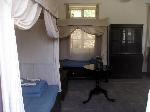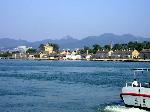- Getting around Lijiang. Dont stay in the Old Towns more than 2 days, there is nothing to do. KRISS Oct 9, 2013 05:46
- 2013 Beijing Temple Fair BENNYLAU Feb 26, 2013 03:29
- Malaysian traveling from KUL - LAX vis Shanghai PVG ZATI_DY Jan 3, 2013 20:15
Smooth Sailing in the Wake of Defeat
- Views: 5071
- |Vote: 0 0
- |Add to Favorites
- |Recommend to Friends
I’m standing in the stern of the ferry looking back across our wake. The water is clear and blue, the sky is too and on shore the white high-rise buildings stand in sharp contrast against the sky. In just a few short minutes our ferry is disgorging another load of day-trippers at the islands visitor center. The lure for me was an island surrounded by crystal clear waters, steeped in centuries of history and it is just off the coast of Weihai. Since I am passing through on my way to ‘Land’s End’ at Chengshantou it seems prudent to take a look. Liugong Dao is something I’d been longing for but never thought I’d see so I am unprepared. But the thought of yet another day without a swim is soon swept away by the surrounding beauty of the island.
I’d spent the night in Weihai on my way back from Chengshantou, that picturesque village at the edge of the world. When I got off the bus the afternoon before I’d managed to find a nice cheap room near the bus station for the night. All I had heard about Weihai has been positive and it is living up to my expectations. I am up early the next morning – partly because I haven’t slept well on account of marauding mosquitoes throughout the night - but I want to make the most of another beautiful day and I’m unsure of what I will find.
Historically, Weihai has played a significant role in the defense of Beijing including China’s demoralizing defeat by the Japanese Navy in 1894. Liugong Dao together with Dalian and the port of Lushun were home to China’s Northern Naval Fleet that at the time of the confrontation numbered around forty vessels many of them bought or borrowed from Britain and Germany. Ding Ruchang, the Naval Commander at the time was a man of action, having proven himself throughout his career: he made his way through the ranks to his final and fateful position. In 1880 he was sent to Britain to deliver two new battleships, the ‘Chaoyang’ and the ‘Yangwei’. The first modern ships in the Chinese fleet as they began to recognize the wisdom of equipping their navy with the same caliber of craft that the had allowed countries like Britain, Germany and America to gain control and maintain their foothold in the Treaty Ports along the China coast.
In 1890 with the assistance of the British, Ding Ruchang set up a Naval Training School for Chinese Officers on Liugong Dao. Despite this training by the British, the Japanese were able to outwit and out maneuver the Chinese Fleet with many of her ships floundering as they fled westward before the ominous advance of the Rising Sun. Ding Ruchang, overcome with shame at the destruction of his fleet by the smaller Japanese flotilla took his own life in 1895. The British eventually took control of the island three years later, and during more than thirty years that the British controlled the island they built a Naval Academy, a hospital, a school, churches, residences and the island became a popular summer resort for the British Navy and today is another well-preserved example of foreign influence on the Peninsular.
The evening before I had been assured that I could easily get to the docks from my hotel. The bus stop was just across the intersection. I am in luck - there is a bus waiting at the stop when I arrive but it is soon evident that it is not going anywhere despite being packed. It has just had a minor altercation with a taxi – both drivers were on the street loudly voicing their opinions and gesturing wildly with their hands - the female taxi driver had pulled out in front of the bus. I wait, watch and listen for a few more minutes as the crowd of waiting passengers grows. The next bus, when it arrives would be crowded too so I hail down a taxi and head for the port where I eat breakfast before taking the ferry out to Liugong Dao.
Escaping the crowds is easy. Turning to the left after exiting the arrivals building I follow the old docks past the two story brick barracks and some modern gray patrol boats to the southerly tip of the island which faces the mainland just a few kilometers way. Dotted around the island are the remains of cannons and underground bunkers with a tunnel network. From here I follow the narrow flagged streets up the gentle slope exploring the beautifully preserved officers quarters, classrooms, and officers residences. On a small headland overlooking the passage between the island and the mainland I stumbled across another cannon placement. What a stunning view through wind swept, stunted conifers, back to the mainland, along the rugged coastline and westward towards the distant capital of the Middle Kingdom.
Just above the settlement is landscaped parkland with a small memorial to the Revolution. Much of the island is a nature reserve covered in forest from the islands peak down to the rugged western shore and a cable car carries visitors up for a 360 view. I spend several hours wandering the quiet cobbled streets, inspecting the neat but Spartan Naval Academy, the temple and small galleries and museums. Liugong Dao is a hikers paradise with just a few small roads and goat tracks across the island. As the sun rises higher in the sky I slip down to the beach beneath the concrete bow of the Jiawu Naval Museum, a tribute to the 1894/95 Sino-Japanese battle. Ding Ruchang, immortalized in stone, telescope in hand, eyes scanning the horizon stands wind swept and watching from the deck of his memorial.
Liugong’s history is a turbulent one, swinging from rural revolutions and prosperous trade through epidemic disease. Legend also has it that a merchant ship, floundering during a fierce storm, her crew fearful for their lives is drawn to the island by a mysterious light. When close enough the men leap ashore in shallow water collapsing exhausted at the feet of an old man holding the torch that had guided them in. He then helps each man, shouldering them one by one on his back into his house where his wife reputedly feeds this ravenous crew from a pot of rice that never empties. When the men rise the following morning they find the couple mysteriously gone and the local residents explain that these celestial beings often give assistance to sailors. Ironically, today there are no residents with this legendary family name.
I take my shoes off to wade in the cool refreshing water. The beach is small, narrow and none to clean but the water glistens like gold in the sunlight as each little wave tumbles in. Surprised by the sparkling in the water I take a closer look and discover gold flakes - fools gold, I suspect - tumbling in the gentle waves. I wander slowly at the waters edge, looking for shells and coral and flotsam from the sea. The beach is awash with bits of lime green kelp looking more like discarded plastic shopping bags until closer inspection reveals the truth. My thoughts return to swimming but I have no bathers and nowhere discrete to change. I’m not the only person combing the beach that afternoon looking for who knows what. While I find nothing of real interest I do collect some small bright red clamshells to add to my collection of nautical mementos from places I have been - pebbles and shells or corals from around the world.
Off shore, small fishing boats lie quietly at anchor. The passing of larger deep sea fishing vessels and outer island ferries is announced by the sudden slapping on the sand of many small waves produced by their wakes making landfall. An upturned dinghy - her timber planks shrinking and her green paint peeling - lies rotting in the sun above the high water line. Another larger battle-scarred rusting hulk sits propped upright also rotting in the long grass above the beach, what’s left of her crisp white coat suggesting a more glorious past. In the background the bow of the museum thrusts proudly seaward - hard gray lines in concrete. I look back on this trio of silent stranded hulls – one of concrete, one of steel and one of timber – a fitting tribute to the sea faring history of this island.
The beach ends in a small headland. Rather than return along the beach I clamber up to the road following it further out around the coast but there is little to see. Unseen dogs bark at my approach before I turn walking back through the small village behind the museum. Flanking me on the right is the central forested peak of the island. The tree-lined street is cool but I stop to buy an icecream from one of the small poorly stocked local stores. I choose to skip the Jiawu Museum as I’ve gleaned enough information from the much smaller, free exhibition halls in the temple complex on the slope above the arrivals hall. I buy what turns out to be a very cheap string of black cultured pearls which last only a month before the silver wears off and the clap collapses. I dawdle past the elegant new hotel, the first on the island, browse through the souvenir shops and enjoy an ice-cold bottle of water and a snack while I rest in the breezeway of the buildings that house the cable car station.
Back on the mainland, I have a couple of hours to kill. While I find little of exceptional interest I am sure there are things to discover given more time. Today the city is booming – a manufacturing base for a cute little three-wheeled car, tyres, clothing and accessories, seafood and other food products and clocks, an industry that began more than a century ago. Another Shandong specialty is beer and Weihai is no exception being home to a joint venture with Korea’s Asahi brand and home to her own brew, Weihaiwei that proudly bears the city’s historic name. Weihai, fully recovered from her inglorious past is embracing her future with the same gusto and confidence that Ding Ruchang expressed during his days of glory.
Yantai to Weihai by bus Y26 (from west bus station) less from downtown
Liugong Dao Ferry Y50 for return trip. Every 20 mins from 7.00am to 5.30pm
Liugong Dao – No entrance fee to island but expect to pay for the Museum and several other sites
Bus/Train station to the dock Luyou Matou Take bus no 1 (Y1) or taxi Y17
Hotels – currently one hotel , price range begins from less than Y200
Bus to Chengshantou leaves every 40 mins Y12 takes 1 hour
Last bus leaves Changshantou for Weihai @ 4.00pm
Hotels in and near Changshantou but avoid peak holidays










 Copyright © 1998-2025 All rights reserved.
Copyright © 1998-2025 All rights reserved.